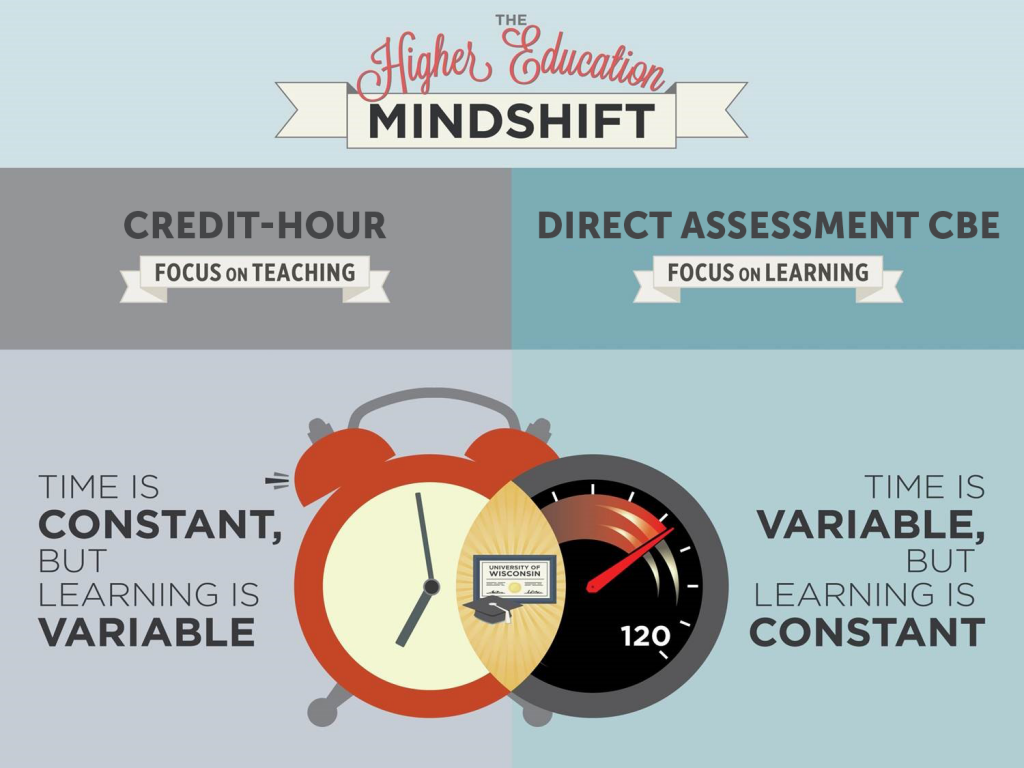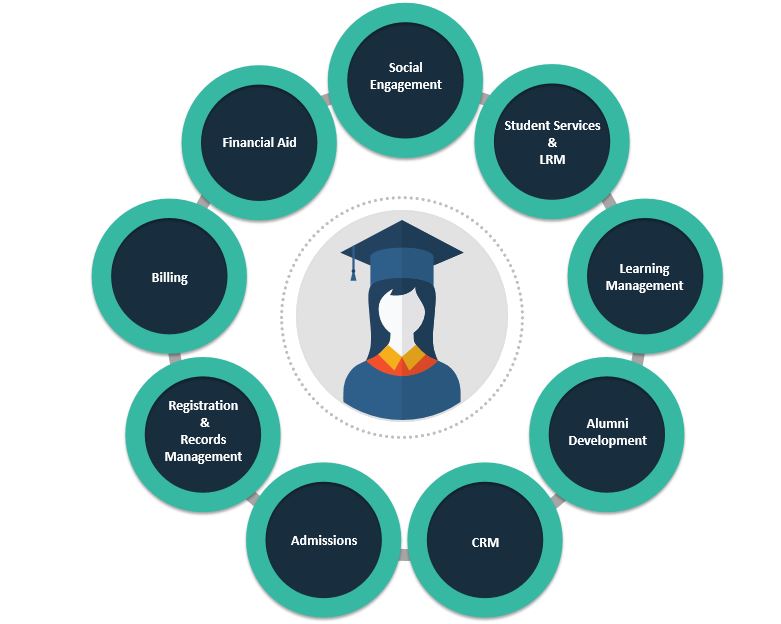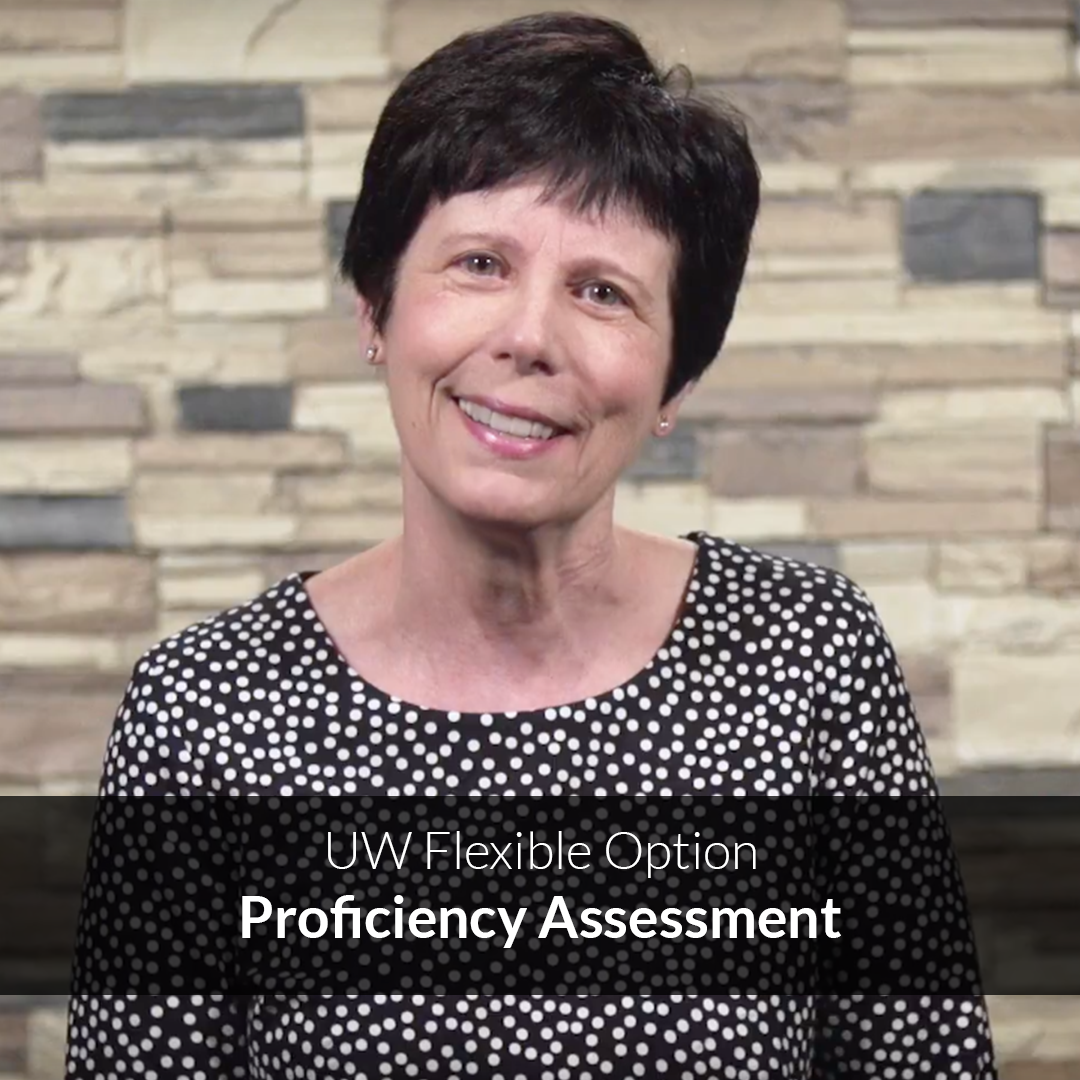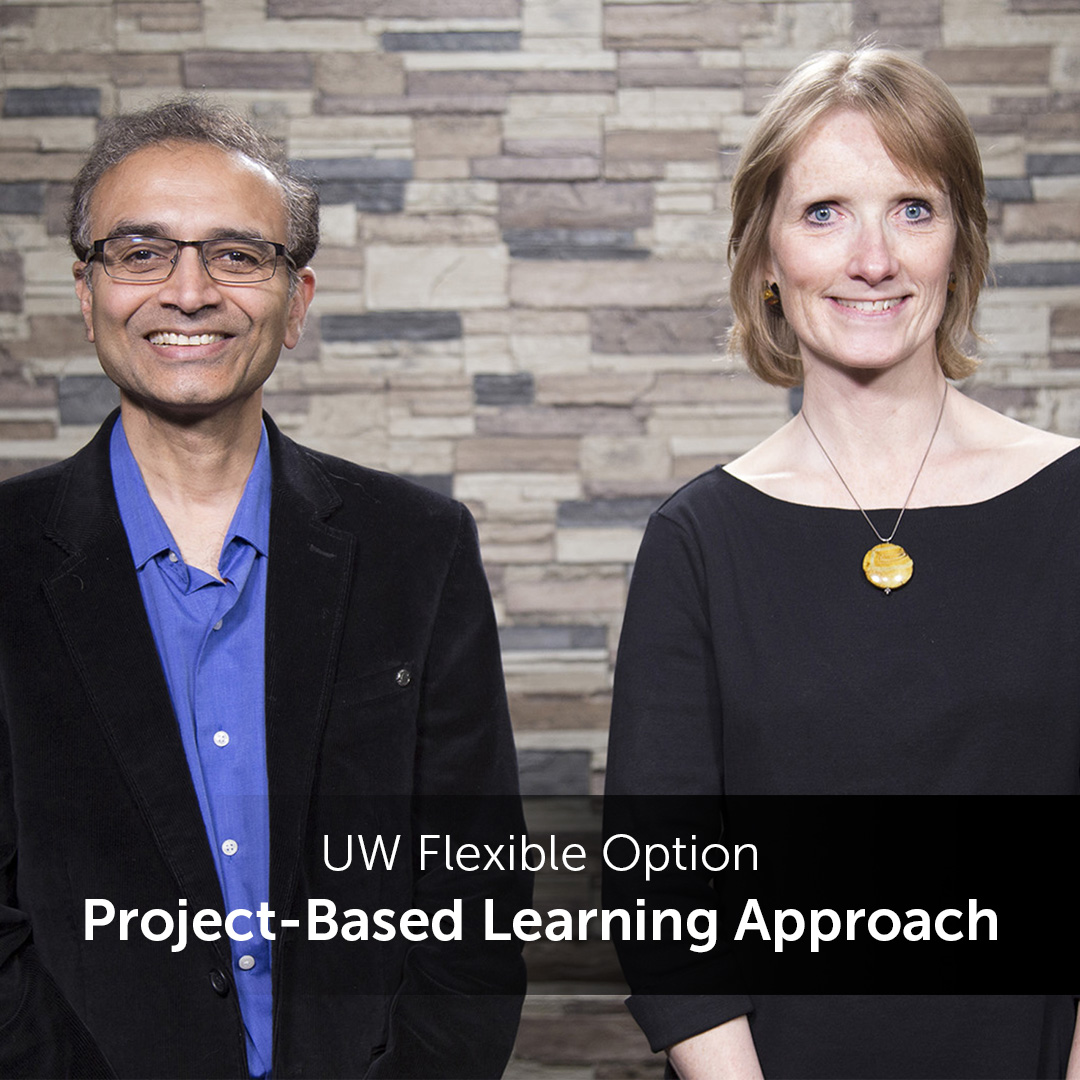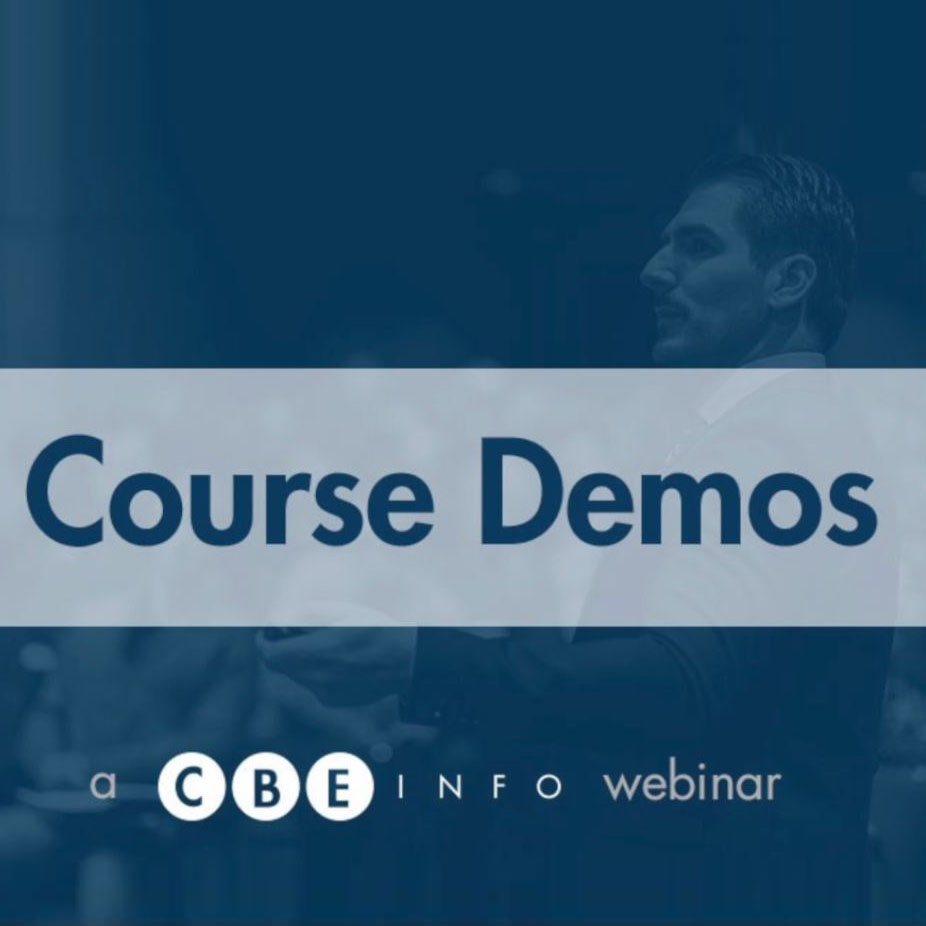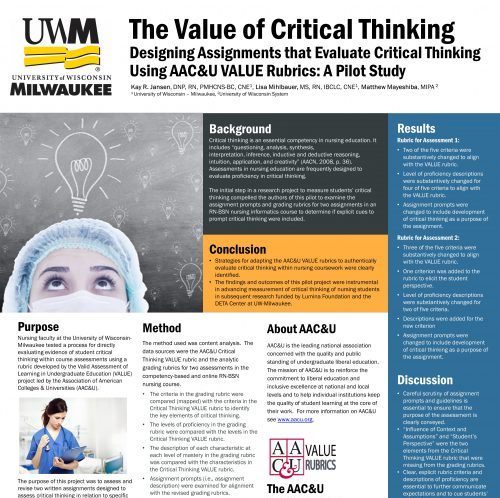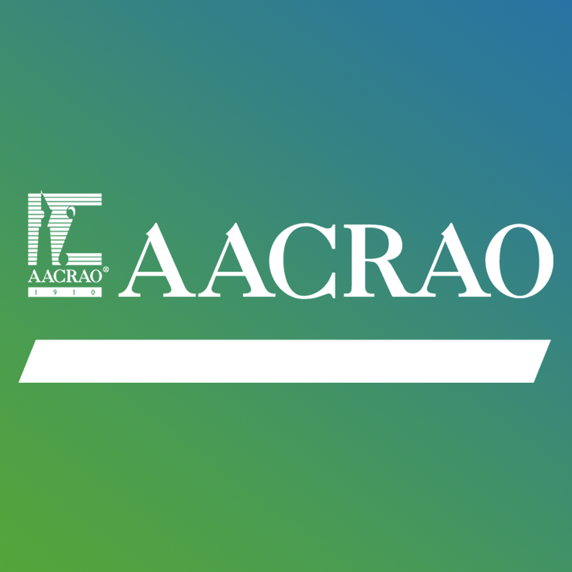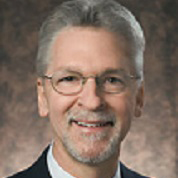Key takeaways
- Ongoing professional development helps faculty and staff focus on the direct assessment competency-based model during curriculum development and delivery.
Read more...
Curriculum development differs considerably from a traditional online course. Entering the direct assessment CBE world requires learning a new language, a new culture, and a new approach to educational design.
One UW Flexible Option nursing faculty workshop, for example, focused on proficiency assessment.
Carleen Vande Zande, UW System interim associate vice president of Academic Programs and Educational Innovation, who presented a proficiency assessment workshop for UW Flex nursing faculty, provides an overview of the topic and shares faculty “aha moments.”
Training is necessary not only for faculty but for staff, including instructional designers, student support staff (such as enrollment advisors and Academic Success Coaches), and marketing and recruitment staff.
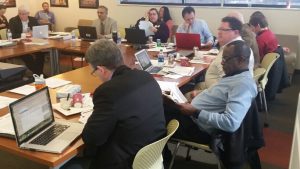
Continuous training helps faculty and staff assimilate the culture and approach of CBE. Onboarding faculty and staff new to UW Flex is essential but not sufficient. Ongoing professional development helps them focus on the model. This level of professional development requires a sustainable training model, which will vary by institution. Components might include a well-financed plan budgeted from the start, regularly scheduled meetings, and a design that withstands program growth per the institution’s business model.
- Putting students at the center of the UW Flexible Option model provides direction for curriculum development and support for student success.
Read more...
Direct assessment CBE centers on student success and learning outcomes. For the UW Flexible Option, this led to an overarching focus on students that permeates everything from development of the curriculum design and delivery model to faculty and staff professional development. Examples include:
- The curriculum design and delivery model is a non-term program that provides students access to learning outcomes, curated content (learning resources), practice assessments and feedback, and Academic Success Coach support as they create an Individualized Learning Plan and prepare to prove mastery of competencies—all on their own schedules.
- The learning environment provides an intuitive user experience with consistent organization of materials and persistent links to technology support, academic resources, library support, tutoring, a writing lab, and Academic Success Coaches. This allows students to focus on mastering content instead of learning navigation.
- The curriculum allows for assessments related to the student’s goals, which helps sustain motivation.
- While developing curriculum, faculty and instructional designers build in choice, allowing self-determined pacing and, as appropriate, sequencing. They explicitly describe the logic behind projects or assessments to be completed sequentially.
- Academic support is provided through faculty, Academic Success Coaches, and other assistance such as tutoring.
Eileen Horn, an instructional designer with the UW Flexible Option, elaborates in a post on “Designing for Self-Directed, Self-Paced Learners” about development of the Bachelor of Science in Business Administration program (BSBA) program.
The UW Flex focus on nontraditional adult learners provided further direction for all involved in the academic design and development processes. This dedication to nontraditional adult learners also provided context for non-academic program pieces such as operations, marketing, and recruitment.
This UW Flexible Option learning management system preview shows how Bachelor of Science in Business Administration projects are structured and how students might interact with materials.
- Direct assessment CBE program design requires a step-by-step process that begins and ends with outcomes, from broad to the more narrow and detailed.
Read more...
Instructional best practices provide the structure for program design in the UW Flexible Option. While not unique to direct assessment CBE, practices incorporated by faculty and staff include the use of backward design and tested disciplinary strategies for supporting student learning. An infographic of the Step-by-Step Process for UW Flexible Option Curriculum Development (to print, see version below in “More detail”) and webinars on development of the Bachelor of Science in Business Administration project-based degree (by UW-Extension’s Ryan Anderson in a CBE Info webinar) and “The Nuts and Bolts of Developing and Delivering the Flex Curricula” provide details.
 The UW Flexible Option sets up instruction via the resources, rubrics, scaffolding, and sequencing of when students do what steps for maximum learning.
The UW Flexible Option sets up instruction via the resources, rubrics, scaffolding, and sequencing of when students do what steps for maximum learning.Carleen Vande Zande, then UW Oshkosh associate vice chancellor of curricular affairs and student academic achievement and later UW System interim associate vice president for Academic Programs and Educational Innovation, at a May 2016 assessment workshop for UW-Milwaukee nursing faculty
- The Bachelor of Science in Business Administration degree provides an example of the project-based learning approach.
Read more...
Suresh Chalasani of UW-Parkside and Judee Richardson of UW-Extension talk about development of the project-based Bachelor of Science in Business Administration degree.
- Administrative task efficiencies improve the ability to scale.
Read more...
Cognizant of the complexities of direct assessment CBE curriculum development, the UW Flex team looked for ways to simplify administrative tasks that impact faculty, staff, and students.
The instructional design team, for example, developed a process and reasonable schedule for curriculum revision. For most programs, a third of the curriculum is updated annually (exceptions include fields with rapid changes, such as information technology). A predictable schedule permits faculty to plan time for this task, ensures efficient use of instructional design staff time spent updating, and minimizes disruptions for students accessing the curriculum.
Additional examples of administrative efficiencies include organization and simplification of learning management systems processes for both faculty and students, clearly outlined expectations in faculty agreements, provision of metrics reports so that faculty can monitor their program and student performance, and student-friendly interactive transcripts that allow students to monitor their own performance and progress (under development in 2017).
This approach contributes to the ability to scale programs and recover costs in the UW Flexible Option model.
Challenges
- The cultural shift required on the part of faculty and staff takes time and effort, compounded by ill-fitting technology and regulations based on the credit hour.
Read more...
UW Flex early response: Senior leaders recognized that change of this magnitude would be difficult and wouldn’t happen through a single workshop. The shift from traditional education to direct assessment CBE impacted faculty roles and staff roles, including interactions with students; the educational lexicon; and the design, delivery, and very ownership of curriculum.
For UW Flex faculty and staff, this shift preceded the development of regulations and technology designed for direct assessment CBE programs versus traditional credit hour programs. As a result, they faced complications, confusion, and compromises, such as the U.S. Department of Education requirement to crosswalk academic content back into the credit-hour format in order to be eligible for Title IV funding. (The third challenge in this section elaborates on this issue.)
Acknowledgement of the challenges, repeat exposure to the direct assessment CBE model, and the provision of ample support helped alleviate frustrations that arose during curriculum development. Support included workshops, the creation of “how-to” documents, one-on-one sessions between faculty and instructional designers, and other communications to reinforce the divorce from the traditional model.
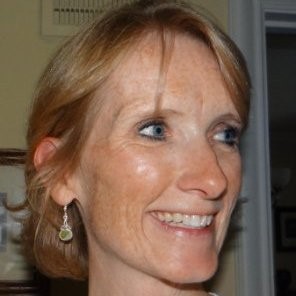 Faculty come away from the experience enthusiastic, energized, and ready to apply what they have learned through this competency-based process to then revise and improve their traditional brick-and-mortar and online course content.
Faculty come away from the experience enthusiastic, energized, and ready to apply what they have learned through this competency-based process to then revise and improve their traditional brick-and-mortar and online course content.Judee Richardson, director of academic and curricular development for UW-Extension, writing in this commentary for the April 2016 Journal of Competency-Based Education
Looking forward from 2017: Wisconsin faculty will be increasingly exposed to CBE through the UW Flexible Option. Cultural shifts are challenging at any institution and invariably follow a bell curve model. The key is to provide opportunities for faculty to experience CBE and teach in CBE models, and for administrators and staff to understand how CBE works and recognize the value to students and institutions.
In addition, cultural shifts are likely to happen at the federal level as Congress revises current regulations to better support CBE models.
- Technology has not kept up with the evolution of CBE.
Read more...
UW Flex early response: Higher education institutions, such as Alverno College in Milwaukee, have employed a CBE approach for decades. Existing educational technology served needs of programs still based on the credit hour. The same is not true for newer CBE models that are self-paced, non-term, direct assessment programs, such as the UW Flexible Option. With educational technology systems based on the traditional model, UW Flex staff had to adapt and build structures to assemble its Student Engagement System. Structures designed for traditional models were inflexible and cumbersome for CBE, such as learning management systems available 2013-16 for revising and replacing academic content. Responding to the lag in technology in the early years of UW Flex, the staff spent extra time and resources on workarounds and problem-solving. For example, staff completed a number of steps manually early on, such as historical accounts of student issues logged in email streams versus automated reports.
Also, as a founding member of C-BEN, UW Flex staff contributed to the 2015 Technical Interoperability Pilot project designed to “speed the delivery to market of quality CBE-supporting software, serving as a market accelerator for interoperable solutions supporting CBE program delivery.” Through a partnership with the IMS Global Learning Consortium, the work included a survey to identify common problems, as vendors, understandably, did not want to risk resources on developing solutions for a narrow market. Survey results were shared with vendors. A common understanding of the technical issues experienced by C-BEN members appears to be a good first step for vendors interested in meeting the software needs of direct assessment CBE programs.
Looking forward from 2017: The UW Flexible Option is creating a fully functioning standardized central system, the Student Engagement System, which incorporates nine components:
- Student Services and Learning Relationship Management (LRM)
- Learning Management System (LMS)
- Alumni Development
- Customer Relationship Management (CRM)
- Admissions
- Registration and Records Management
- Billing
- Financial Aid
- Social Engagement
- All current academic performance records and Title IV financial aid are based on the credit hour and time rather than on learning outcomes and a flexible educational pace.
Read more...
UW Flex early response: Judee Richardson, director of academic and curricular development for UW-Extension, said, “Like other programs offering, direct assessment CBE we faced challenges implementing our academic model within a regulatory environment rooted in traditional education practices, processes, procedures, and rules. We have been working with the Higher Learning Commission (HLC) and the Department of Education to develop new alternative pathways.”
Meanwhile, UW Flex staff has had to crosswalk mastery levels back to traditional grades and credit equivalencies, as is described in Mastery, Grades, and Grade Point Average. This is required by the Department of Education for Title IV eligibility, by the HLC for accreditation, and by higher education institutions for student transferability.
Initially, UW Flex students eligible for Title IV federal financial aid were offered grants funded through UW System. In 2014, the UW Flexible Option became the first direct assessment CBE public university system program approved to offer Title IV financial aid.
UW Flex staff also contributed to the 2015 Bill and Melinda Gates Foundation-funded Technical Interoperability Pilot project that, in part, explored barriers related to federal financial aid in self-paced programs. (See the previous challenge.)
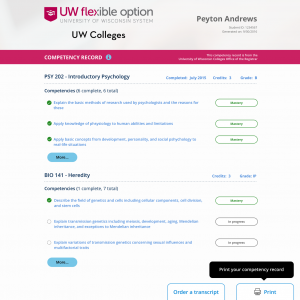 In addition, UW-Extension, which provides leadership for UW Flex, and UW Colleges, which offers its associate degree via UW Flex, both participated in the 2015-16 Comprehensive Student Record Project funded by Lumina Foundation and led by the American Association of Collegiate Registrars and Admissions Officers and NASPA: Student Affairs Professionals in Higher Education. The project was designed to create comprehensive digital transcript models that could capture learning outcomes, competencies, and co-curricular activities. The UW Flexible Option introduced the SmartScript competency-based transcript first for students in the Bachelor of Science in Business Administration degree program offered through UW-Extension since December 2016.
In addition, UW-Extension, which provides leadership for UW Flex, and UW Colleges, which offers its associate degree via UW Flex, both participated in the 2015-16 Comprehensive Student Record Project funded by Lumina Foundation and led by the American Association of Collegiate Registrars and Admissions Officers and NASPA: Student Affairs Professionals in Higher Education. The project was designed to create comprehensive digital transcript models that could capture learning outcomes, competencies, and co-curricular activities. The UW Flexible Option introduced the SmartScript competency-based transcript first for students in the Bachelor of Science in Business Administration degree program offered through UW-Extension since December 2016.Looking forward from 2017: As the Associate of Arts and Science curriculum is reviewed (a third each year), UW Flexible Option staff are coding competencies and expect that the SmartScript will be available for students in that degree program in 2019. The goal is to have all participating UW Flex institutions adopt the SmartScript format.
 Ultimately, this record will allow users to customize a display and drill down, and verify the credentials and the learning outcomes. Beyond just listing course titles and delivering terse information in a chronological format, they’ll help the student tell the story of their education.
Ultimately, this record will allow users to customize a display and drill down, and verify the credentials and the learning outcomes. Beyond just listing course titles and delivering terse information in a chronological format, they’ll help the student tell the story of their education.Dan Kellogg, registrar for the University of Wisconsin-Extension, quoted in an AACRAO post on “SmartScript: A model competency-based transcript” in 2016
In addition, UW Flexible Option senior leaders expect that regulatory agencies and regional accreditors likely will either create a parallel path or integrated process for CBE institutions. They ideally will spell out specific metrics, goals, or milestones that all institutions have to provide, meet, or adhere to but allow for variations in the educational pathways. See the Policy content area of this website for details.
- Compensation and workload issues affect faculty engagement.
Read more...

University of Wisconsin System business and economics faculty members from around the state met to develop the Bachelor of Science in Business Administration curriculum. UW Flex early response: Dramatic differences in the educational model and faculty roles require adjustments in compensation and workload. When not incorporated into the workload, CBE becomes an add-on or overload. In that case, it predictably takes a back seat to the teaching load, research, and service expected of faculty, in particular for those pursuing tenure/promotion. Tenure-track faculty, for example, experience the pressure to publish, which reduces capacity to engage in CBE curriculum development and delivery.
Also, a self-paced program such as UW Flex further complicates faculty workload since students enjoy the flexibility of completing assessments at any point during the subscription period—including the last few days. Grading turnaround time becomes more challenging when faculty do not control the workflow.
UW Flex senior leaders and faculty continued the workload and compensation conversation in 2016-17.
Looking forward from 2017: UW Flexible Option senior leaders expect that CBE faculty and academic staff workloads will become part of regular academic contracts, departments will incorporate CBE into regular instructional activities and assign faculty and instructional staff accordingly, and involvement in UW Flex will be evaluated for tenure and promotion just as other instructional activities are evaluated for the same.
- The CBE field lacks well-developed tools faculty can use for competency development.
Read more...
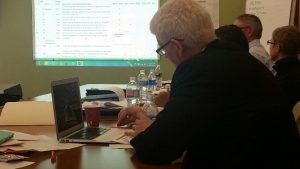
UW Flexible Option faculty and instructional designers meet
face-to-face to identify
program-level competencies.
UW Flex early response: Staff recognized that the process of identifying program-level competencies is time-consuming and requires multiple discussions. They devoted the time to this professional development and to creating and revising “how to” documents. They employed a wide variety of resources (such as charts, worksheets, illustrations, narratives) to build understanding.
Looking forward from 2017: There is a growing body of work to support institutions and faculty exploring direct assessment CBE program development, much of which is accessible through this website’s CBE Resources. In addition, UW program faculty and staff will create institution-specific tools to complement resources and best practices compiled and vetted by organizations such as C-BEN and Lumina Foundation.
